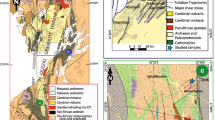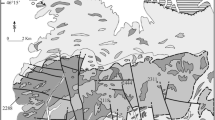Summary
Potassium-fluor-richterite is reported from wollastonite-rimmed metachert bands embedded in marbles of the Bufa del Diente aureole, NE-Mexico. K-F-richterites were generated via reaction of previously formed contact-metamorphic diopside with infiltrated hypersaline brines of magmatic origin that used the metachert bands as metamorphic aquifers. Their formation occurred at peak metamorphic conditions of 500 to 600 °C at 1 kbar according to the generalised reaction 10 CaMgSi2O6 + 8 SiO2 + 2 KClaq + 6 NaClaaq + 4 H2O + 4 HF diopside + quartz = 2 KNaCaMg5Si8O22(F)2 + 4 Ca2NaH(SiO3)3 + 8 HClaq K-F-richterite + pectolite Compositional ranges in two samples are K-Ri58−69Ri16−25Tri12−21 and K-Ri58−66Ri32−40Tr0−5. Mg/(Mg + Fe2+) ranges from 0.81 to 0.95, F/(F + OH) from 0.55 to 0.85, and the K-F-richterites are Cl-free.
Microthermometrically determined K/(K + Na)-ratios of hypersaline brines trapped at 500°C to 600°C range from 0.50 to 0.64, resulting in distribution coefficients K Amph-F1DK-Na = X AmphK(in A) /X AmphN(in A) · X F1Na /X F1K of 0.85 to 1.3 for the Na-K amphibole-fluid exchange reaction. Very low Ca-contents in bulk fluid leachates indicate that Cacontaining fluids cannot coexist with richterite and that Ca is incorporated into amphibole as a tremolite component. Amphibole compositions in Al-free systems can predict Na-K-Ca-ratios of metasomatic brines that equilibrated with them. Despite the hypersaline nature of the brines, Cl is not incorporated into the Mg-rich K-F-richterites because of the Mg-Cl and Fe-F avoidance rules in amphiboles.
Zusammenfassung
In die Marmore der Kontaktaureole des Bufa del Diente-Alkalisyenits sind 5-15 cm mächtige Quarzitbänder eingeschaltet, die mehrere cm-dicke Wollastonitsäume aufweisen. Die Metaquarzite enthalten Kalium- und Fluor-reiche Richterite. Die K-FRichterite bildeten sich durch Reaktion von zuvor gebildetem, kontaktmetamorphem Diopsid mit infiltrierenden hochsalinaren Fluiden magmatischen Ursprungs. Die Metaquarzite dienten als metamorphe Aquifere für diese Fluide.
Die K-F-Richterite wurden bei den Maximaltemperaturen der Kontaktmetamorphose von 500-600°C bei 1 kbar nach der folgenden schematischen Reaktion gebildet: 10 CaM9Si2O6 + 8 SiO2 + 2 KClaq + 6 NaClaq + 4 H2O + 4 HF Diopsid + Quarz = 2 KNaCaMg5Si8O22(F)2 + 4 Ca2NaH(SiO3)3 + 8 HClaq K-F-Richterit + Pektolit Der Zusammensetzungsbereich von zwei Proben aus unterschiedlichen Metaquarzitbändern liegt bei K-Ri58–69Ri16–25Tr12–21 und K-Ri58–66Ri32–40Tr0–5. K-FRichterite in beiden Proben haben F/(F + OH)-Verhältnisse von 0.55 bis 0.85 und enthalten kein Cl.
Mikrothermometrisch bestimmte K/(K + Na)-Verhältnisse der bei 500°-600°C in Flüssigkeitseinschlüssen okkludierten, hochsalinaren Fluide betragen 0.50–0.64. Daraus lassen sich Verteilungskoeffizienten K Amph-FiDK-Na = X AmphK(in A) /X AmphN(in A) · X F1Na /X F1K von 0.85-1.3 für die Amphibol-Fluid Austauschreaktion in tremolitfreien Amphibolen ableiten. Wässrige Extrakte der Gesamtfluidpopulationen enthalten sehr geringe Ca-Konzentrationen im Vergleich zu K und Na. Dies zeigt, daß Fluide mit signifikanten Ca-Konzentrationen nicht mit Richteriten koexistieren können und Ca bevorzugt als Tremolitkomponente eingebaut wird. Amphibolzusammensetzungen in Al-freien Systemen eignen sich als Indikatoren für K-Na-Ca-Verhältnisse von koexistierenden metasomatischen Fluiden. Die K-F-Richterite sind Cl-frei, obwohl sie mit hochsalinaren Fluiden koexistiert haben. Mg-reiche Amphibole können kein CI einbauen und Fe-reiche Amphibole kein F.
Similar content being viewed by others
References
Carmichael ISE (1967) The mineralogy and petrology of the volcanic rocks from the Leucite Hills, Wyoming. Contrib Mineral Petrol 15: 24–66
Dawson JB, Smith JV (1977) The MARID (mica-amphibole-rutile-ilmenite-diopside) suite of xenoliths in kimberlite. Geochim Cosmochim Acta 41: 309–323
Deer WA, Howie RA, Zussman J (1963) Rock-forming minerals, vol 2. Chain silicates. Longmans, Green and Co, London, 379pp
Della Ventura G, Maras A, Parodi GC (1983) Potassium-fluorrichterite from Monte Somma (Campania, Italy). Periodico de Mineralogia 52: 617–630
Erlank AJ, Waters FG, Hawkesworth CJ, Haggerty SE, Allsopp HL, Rickard RS, Menzies MA (1987) Evidence for mande metasomatism in peridotite nodules from the Kimberley pipes, South Africa. In:Menzies MA, Hawkesworth CJ (eds) Mantle metasomatism. Academic Press, London, pp 221–311
Heinrich W (1993) Fluid infiltration through metachert layers at the contact aureole of the Bufa del Diente intrusion: implications for wollastonite formation and fluid immiscibility. Am Mineral 78: 808–814
Jones AP, Smith JV, Dawson JB (1982) Mantle metasomatism in 14 veined peridotites from Bulfontein mine, South Africa. J Geol 90: 435–453
Korzhinskiy MA (1981) Apatite solid solutions as indicators of the fugacity of HCl° and HF' in hydrothermal fluids. Geochim Int 18: 44–60
Menzies MA, Rogers N, Tindle A, Hawkesworth CJ (1987) Metasomatic and enrichment processes in lithospheric peridotites, an effect of asthenosphere-lithosphere interaction. In:Menzies MA, Hawkesworth CJ (eds) Mantle metasomatism. Academic Press, London, pp 313–361
Morrison J (1991) Compositional constraints on the incorporation of Cl into amphiboles. Am Mineral 76: 1920–1930
Mottana A, Griffin WL (1986) Crystal chemistry of two coexisting K-richterites from St. Marcel (Val d'Aosta, Italy). Am Mineral 71: 1426–1433
Ramirez-Fernandez JA, Heinrich W (1991) Geology of the Tertiary Bufa del Diente intrusion and its contact aureole, Sierra de San Carlos, Tamaulipas, Mexico. Zentralblatt für Geologie und Paläontologie (Teil 1) 6: 1519–1531
Thy P (1982) Richterite-arfvedsonite-riebeckite-actinolite assemblage from MARID dikes associated with ultrapotassic magmatic activity in central west Greenland. Terra cognita 2: 247–249
Troll G., Gilbert MC (1972) Fluorine-hydroxyl substitution in tremolite. Am Mineral 57: 1386–1403
Velde D (1978) An aenigmatite-richterite-olivine trachyte from Puu Koae, West Maui, Hawaii. Am Mineral 63: 771–778
Volfinger M, Robert JL, Vielzeuf D, Neiva AMR (1985) Structural control of the chlorine content of OH-bearing silicates (micas and amphiboles). Geochim Cosmochim Acta 49: 37–48
Wagner C, Velde D (1986) The mineralogy of K-richterite-bearing lamproites. Am Mineral 71: 17–37
Zhang YG, Frantz JD (1989) Experimental determination of the compositional limits of immiscibility in the system CaCl2-H2O-CO2 at high temperatures and pressures using synthetic fluid inclusions. Chem Geol 74: 289–308
Zhu C, Sverjensky DA (1991) Partitioning of F-CI-OH between minerals and hydrothermal fluids. Geochim Cosmochim Acta 55:1837–1858
Author information
Authors and Affiliations
Additional information
With 4 Figures
Rights and permissions
About this article
Cite this article
Heinrich, W. Potassium-fluor-richterite in metacherts from the Bufa del Diente contact-metamorphic auréole, NE-México. Mineralogy and Petrology 50, 259–270 (1994). https://doi.org/10.1007/BF01164609
Received:
Accepted:
Issue Date:
DOI: https://doi.org/10.1007/BF01164609




